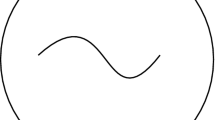Abstract
Podestà and Spiro (Osaka J Math 36(4):805–833, 1999) introduced a class of G-manifolds M with a cohomogeneity one action of a compact semisimple Lie group G which admit an invariant Kähler structure (g, J) (“standard G-manifolds”) and studied invariant Kähler and Kähler–Einstein metrics on M. In the first part of this paper, we gave a combinatoric description of the standard non-compact G-manifolds as the total space \(M_{\varphi }\) of the homogeneous vector bundle \(M = G\times _H V \rightarrow S_0 =G/H\) over a flag manifold \(S_0\) and we gave necessary and sufficient conditions for the existence of an invariant Kähler–Einstein metric g on such manifolds M in terms of the existence of an interval in the T-Weyl chamber of the flag manifold \(F = G \times _H PV\) which satisfies some linear condition. In this paper, we consider standard cohomogeneity one manifolds of a classical simply connected Lie group \(G = SU_n, Sp_n. Spin_n\) and reformulate these necessary and sufficient conditions in terms of easily checked arithmetic properties of the Koszul numbers associated with the flag manifold \(S_0 = G/H\). If this condition is fulfilled, the explicit construction of the Kähler–Einstein metric reduces to the calculation of the inverse function to a given function of one variable.
Similar content being viewed by others
References
Alekseevsky, D.: Flag manifolds, 11. Yugoslav Geometrical Seminar, Divcibare, 10-17 October, pp. 3–35 (1993)
Alekseevsky, D., Zuddas, F.: Cohomogeneity one Kahler and Kahler–Einstein manifolds with one singular orbit I. Ann. Global Anal. Geom. 52(1), 99–128 (2017)
Alekseevsky, D., Chrysikos, J.: Spin structures on compact homogeneous pseudo-Riemannian manifolds. Transf. Groups 24(3), 659–689 (2019)
Alekseevsky, D.V., Perelomov, A.M.: Invariant Kaehler–Einstein metrics on compact homogeneous spaces. Funct. Anal. Appl. 20(3), 171–182 (1986)
Alekseevsky, D., Cortes, V., Hasegawa, K., Kamishima, Y.: Homogeneous locally conformally Kähler and Sasaki manifolds. Int. J. Math. 26, n5 (2015)
Arvanitoyeorgos, A.: Geometry of flag manifolds. Int. J. Geom. Methods Mod. Phys. 3(5, 6), 957–974 (2006)
Achmed-Zade, I., Bykov D.: Ricci-flat metrics on vector bundles over flag manifolds. arXiv:1905.00412 (01/05/2019)
Borel, A., Hirzebruch, F.: Characteristic classes and homogeneous spaces. Amer. J. Math. 80, 458–538 (1958)
Boyer, C.P., Galicki, K.: Sasakian Geometry. Oxford Mathematical Monographs. Oxford University Press, Oxford (2008)
Dancer, A., Wang, M.Y.: Kähler-Einstein metrics of cohomogeneity one and bundle construction for Einstein Hermitian metrics. Math. Ann. 312, 503–526 (1998)
Gorbatsevich, V.V., Onishchik, A.L., Vinberg, E.B.: Structure of Lie Groups and Lie Algebras. Encyclopaedia of Mathematical Sciences Lie Groups and Lie Algebras, III. Springer Verlag
Podestà, F., Spiro, A.: Kaehler manifolds with large isometry group. Osaka J. Math. 36(4), 805–833 (1999)
Snow, D.M.: Homogeneous vector bundles. Group actions and invariant theory (Montreal, PQ, 1988). CMS Conference Proceedings, vol. 10. American Mathematical Society, Providence, RI, pp. 193–205 (1989)
Sparks, J.: Sasaki–Einstein manifolds. Surv. Differ. Geom. 16, 265–324 (2011)
Van Coevering, C.: Calabi–Yau metrics on canonical bundles of flag varieties. arXiv:1807.07256v1 (19/07/2018)
Verdiani, L.: Invariant metrics on cohomogeneity one manifolds. Geom. Dedicata 77(1), 77–110 (1999)
Acknowledgements
The authors are grateful to the anonymous referee for her/his very careful comments which helped to improve the exposition of the paper.
Author information
Authors and Affiliations
Corresponding author
Additional information
Publisher's Note
Springer Nature remains neutral with regard to jurisdictional claims in published maps and institutional affiliations.
D. Alekseevsky was partially supported by Grant No. 18-00496S of the Czech Science Foundation.
F. Zuddas was supported by Prin 2015—Real and Complex Manifolds; Geometry, Topology and Harmonic Analysis—Italy, by INdAM. GNSAGA—Gruppo Nazionale per le Strutture Algebriche, Geometriche e le loro Applicazioni, and by KASBA—Funded by Regione Autonoma della Sardegna.
Appendix: Basic facts on flag manifolds
Appendix: Basic facts on flag manifolds
Let \(F = G/K = \mathrm {Ad}_G Z\), where \(Z \in {\mathfrak {g}}\), be a flag manifold, i.e., an adjoint orbit of a compact semisimple Lie group G with the B-orthogonal
(where B is the Killing form) reductive decomposition
We can decompose \(\mathfrak {k}\) as
where \(\mathfrak {k}'\) is the semisimple part and \(Z(\mathfrak {k})\) is the center. We fix a Cartan subalgebra \(\mathfrak {c}\) of \(\mathfrak {k}\) (hence also of \(\mathfrak {g}\)) and denote by R the root system of the complex Lie algebra \(\mathfrak {g}^{{\mathbb {C}}}\) w.r.t. the Cartan subalgebra \(\mathfrak {c}^{{\mathbb {C}}}\). We set
Then,
where for a subset \(P \subset R\), we set
being \(\mathfrak {g}_{\alpha }\) the root space with root \(\alpha \) and \(V^{\tau }\) means the fix point set in \(V\subset \mathfrak {g}^{{{\mathbb {C}}}}\) of the complex conjugation \(\tau \). Recall that the Killing form induces an Euclidean metric in the real vector space \(i \mathfrak {c}\) and roots are identified with real linear forms on \(i \mathfrak {c}\). We set \(\mathfrak {t}:= i Z(\mathfrak {k}) \subset i \mathfrak {c}\) and denote by
the restriction map.
Definition 7
The set \(R_T =\rho (R_{{\mathfrak {m}}})= R_{{\mathfrak {m}}}|{\mathfrak {t}}\) of linear forms on \(\mathfrak {t}\) which are restriction of roots from \(R_{{\mathfrak {m}}}\) is called the system of T-roots and connected components C of the set \(\mathfrak {t}{\setminus } \{ \mathrm {ker\;}{\bar{\alpha }} ,\, {\bar{\alpha }} \in R_T \}\) are called T-Weyl chambers.
Sets of T-roots \(\xi \) bijectively correspond to irreducible \(\mathfrak {k}\)-submodules \( \mathfrak {m}(\xi ):= \mathfrak {g}(\rho ^{-1}(\xi ))\) of the complexified isotropy module \(\mathfrak {m}^{{\mathbb {C}}}\) of the flag manifold \(F =G/K\).
So a decomposition of the \(\mathfrak {k}\)-modules \(\mathfrak {m}^{{\mathbb {C}}}\) and \(\mathfrak {m}\) into irreducible submodules can be written as
where \(R^+_T :=\rho (R_{{\mathfrak {m}}}^+)\) is the system of positive T-roots associated with a system of positive roots \(R^+\), see [1, 4].
We fix a system of simple roots \(\Pi _W\) of \(R_{{\mathfrak {k}}}\) and denote by \(\Pi = \Pi _W \cup \Pi _B\) its extension to a system of simple roots of R. Let \(R^+ = R^+(\Pi ) \) be the associated system of positive roots and \(R^+_{{\mathfrak {m}}}:= R^+ \cap R_{{\mathfrak {m}}}\). The set \(R^+_T:= \rho (R^+_{{\mathfrak {m}}})\) is called positive T-root set.
We need the following
Theorem 8
[4] There exists a one-to-one correspondence between extensions \(\Pi = \Pi _W \cup \Pi _B\) of the system \(\Pi _W\) of simple system of \(R_{{\mathfrak {k}}}\), T-Weyl chambers \(C\subset \mathfrak {t}\) and invariant complex structures (ICS) J on \(F = G/K\). If \(\Pi _B = \{ \beta _1, \dots ,\beta _k \}\), then the corresponding T-Weyl chamber is defined by \( C = \{ {\bar{\beta }}_1>0, \dots ,{\bar{\beta }}_k >0 \}\) where \({\bar{\beta }} = \rho (\beta )\) and the complex structure is defined by \(\pm i\)-eigenspace decomposition
of the complexified tangent space \(\mathfrak {m}^{{{\mathbb {C}}}} = T_{eK}(G/K)\).
The extension \(\Pi = \Pi _W \cup \Pi _B\) can be graphically described by a painted Dynkin diagram, i.e., the Dynkin diagram which represents the system \(\Pi \) with the nodes representing \(\Pi _B\) painted in black. Such a diagram, which we sometimes identify with the pair \((\Pi _W, \Pi _B)\), allows to reconstruct the flag manifold \(F= G/K\) with invariant complex structure \(J^F\) as follows: The semisimple part \(\mathfrak {k}'\) of the (connected) stability subalgebra \(\mathfrak {k}\) is defined as the regular semisimple subalgebra associated with the closed subsystem \(R_{{\mathfrak {k}}}= R \cap \mathrm {span}(\Pi _W)\) and the vectors \(ih_{j}\) defined by condition
form a basis of the center \(Z({\mathfrak {k}})\). The complex structure is defined by (61).
Now, an element \(Z \in {\mathfrak {t}}\) is called K-regular if its centralizer \(C_G(Z) = K\) or, equivalently, any T-root has a nonzero value on Z. Then, we have the following.
Proposition 9
[4, 8] There exists a natural one-to-one correspondence between elements \(Z \in {\mathfrak {t}}\) and closed invariant 2-form \(\omega _Z\) on G / K, given by
where d is the exterior differential in the Lie algebra \({\mathfrak {g}}\) defined by \(d\alpha (X,Y) = - 1/2\alpha ([X,Y])\) and \(o = eK \in G/K\).
Moreover, regular elements \(Z \in C\) from a T-Weyl chamber C correspond to the Kähler forms \(\omega _Z\) with respect to the complex structure J(C) associated with C, that is they define an invariant Kähler structure \((\omega _Z, J(C))\). The 2-form \( \frac{1}{2\pi }\omega _Z\) is integral if the 1-form \(B\circ Z\) has integer coordinates with respect to the fundamental weights \( \pi _i\) associated with the system of black simple roots \( \beta _i \in \Pi _B\).
Recall that if \(\Pi _W = \{ \alpha _1, \dots , \alpha _m\}\) (resp. \(\Pi _B = \{ \beta _1, \dots , \beta _k\}\)) is the set of white (resp. black) simple roots, then the fundamental weight \( \pi _i\) associated with \(\beta _i\), \(i = 1, \dots , k\), is the linear form defined by
where \(<.,.>\) is the scalar product in \(i\mathfrak {c}^* = \mathrm {span}(R)\) induced by the Killing form.
The B-dual to \( \pi _i\) vectors \(h_i\) form a basis of \(\mathfrak {t}\).
Let \(E_{\alpha } \in \mathfrak {g}_{\alpha }, \, \alpha \in R\), be the Chevalley basis of \({\mathfrak {g}}(R)\) such that \(B(E_{\alpha }, E_{- \alpha }) = \frac{2}{<\alpha , \alpha >}\) We denote by \(\omega _{\alpha } = B\circ E_{\alpha }\) the dual basis of 1-forms. Then, for \(Z \in \mathfrak {t}\)
Indeed,
Definition 10
The 1-form
is called the Koszul form and the dual vector \(Z^{Kos}:= B^{-1} \circ \sigma \) is called the Koszul vector.
Proposition 11
[4] The Koszul vector\(Z^{Kos}\) defines the invariant Kähler–Einstein structure \((\omega _{Z^{Kos}}, J(C))\) on \(F=G/K\), where J(C) is the invariant complex structure associated with the T-Weyl chamber C which is defined by \(\Pi _B\).
Rights and permissions
About this article
Cite this article
Alekseevsky, D., Zuddas, F. Cohomogeneity one Kähler and Kähler–Einstein manifolds with one singular orbit II . Ann Glob Anal Geom 57, 153–174 (2020). https://doi.org/10.1007/s10455-019-09693-6
Received:
Accepted:
Published:
Issue Date:
DOI: https://doi.org/10.1007/s10455-019-09693-6




